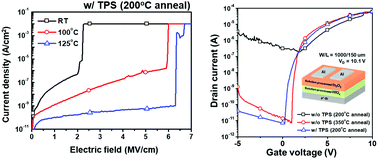Low-temperature fabrication of solution-processed hafnium oxide gate insulator films using a thermally purified solution process†
Abstract
We proposed a simple method, a thermally purified solution (TPS) process, to lower the fabrication temperature of solution-processed hafnium oxide (HfOx) gate insulator films. The TPS process is proceeded by transferring thermal energy to the HfOx precursor solution ‘BEFORE’ film formation. The TPS process could induce chemical reactions including pre-hydrolysis by thermal energy in the HfOx precursor solution. These chemical reactions reduce the required thermal energy for forming a solution-processed HfOx film and improve the film quality. As a result, the HfOx film fabricated via the TPS process has satisfactory dielectric characteristics: a breakdown electric field of ∼6 MV cm−1, a leakage current density of ∼10−9 A cm−2, and a dielectric constant of 10.23 at low temperatures, i.e., below 200 °C. Solution-processed indium oxide (In2O3) thin film transistors with a HfOx gate insulator fabricated via the TPS process exhibit a field effect mobility of 3.67 cm2 V−1 s−1, an on/off current ratio of 9.8 × 106, and a subthreshold swing of 0.18 V dec−1.

- This article is part of the themed collection: Industry R&D collection


 Please wait while we load your content...
Please wait while we load your content...